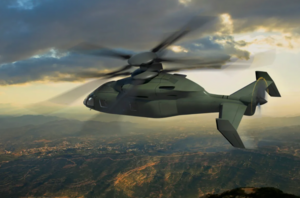KYK-H “Gokei-Sei” Utility Military Helicopter
| KYK-H “Gokei-Sei” | |
|---|---|

| |
| Role | Utility helicopter |
| Manufacturer | Miyamoto Ltd (Neo-Korea), Karasu Ltd (Neo-Korea, KYK-HK variant only), Taeseon Aero (Svetvostok), Juhwan Defense (Svetvostok, KYK-HD variant only), Sam-Il (Svetvostok, KYK-HD variant only) |
| Introduction | 2031 |
| Status | In service |
| Primary user | Neo-Korea / Svetvostok |
| Produced | 2030–present |
| Number built | 120 (Neo-Korea), 240 (Svetvostok) |
Development
The Gokei-Sei emerged as a result of the Joint Helicopter Program, with both nations examining a number of designs until the Akira/Taeseon KYK-H emerged as a viable design. This design originally incorporated shared avionics, but political concerns and an unwillingness on the part of Karasu to share said designs eventually lead to the splitting of the design into the KYK-HK and the KYK-HD variants utilizing domestic avionics. The design was officially approved for production by both nations in 2030, and implementation in both nations begun in 2031.
The Gokei-Sei has been taken as a sign of the potential for future economic and military joint development between Neo-Korea and Svetvostok, and of a sign of the increase in relations which has occurred since the Invasion of Jungg'o. The Neo-Korean State has expressed interest in future joint economic and aviation-based development in the wake of the Gokei, and while no such program has been officially initiated it does not seem to be impossible for such to begin in the relative near future.
Upgrades and variations
Design
Operational history
Neo-Korea
Main Article: 2034 Matsumae Conflict
The KYK-HK variant would see conflict in the Invasion of Matsumae, with the design showing far superior performance to the Suikatta or Hiwamari designs. TBA
Sevtvostok
Variants
VKYK-HZ
Prototype for the production models, incorporating the originally-planned shared sensors systems and experimenting with several differing software models in an attempt to create a mutual information control system. Was found to be greatly effective in testing, but Karasu refused to allow for the continued utilziation of its soft/hard ware in an integrated format with Juhwan, citing concerns of theft or other potential espionage when combined with Svetvostok's utilization of Meridonian technology.
KYK-HK "Gokei-Sei"
Variant utilized by Neo-Korea, utilizing the Gangta Star and Neo-Korean avionics. Additional differences include utilization of propriety software and incorporation into the Karasu CJSS system, allowing it to share targeting data and information which other attached vehicles.
KYK-HD "Gokei-Sei"
Variant utilized by Svetvostok, utilizing the Afanasyev PA-45 and proprietary avionics/software. Additional differences include the lack of incorporation into a CJSS system, a superior Fire Control Radar, and the linking of the proprietary HMD to a specific missile.
Operators
Neo-Korea
Neo-Korea, as one of the original partners to the Joint Helicopter Program, developed and acquired the Gokei-Sei in concert with Svetvostok. Neo-Korea would provide the engines, general design of the body, control scheme, and certain other features to the program, alongside approximately half of the total funding for the program, additionally extending an offer during the initial period to share avionics with Svetvostok, although this would eventually be deemed nonviable for political reasons (thus leading to the split in chosen avionics).
Neo-Korea operates a lesser amount of the craft in comparison to Svetvostok, owing to the presence of the Suikatta in active service, although the latter is slowly being replaced (with a total replacement planned to occur in 2040).
Svetvostok
Svetvostok is buying KYK-HD to replace the TS-35G fleet and TS-32H fleet of long-running helicopters, with 312 new helicopters deployed to the Army and Marine Corps so far. Due to the aging of TS-32H and TS-35G, Svetvostok needs a large number of new helicopters, so the number of KYK-HD helicopters purchased by Svetvostok is expected to increase further in the future.
Specifications
- Crew: 2 pilots + 2 crew chiefs/gunners
- Capacity: 20 soldiers (seated) or 12 Medevac pallets cargo internally, or 4,000kg Slung Load externally
- Length: 19.5m (64ft)
- Width (Fuselage): 2.36m (7ft 9in)
- Height: 4.6m (15ft 1in)
- Main Rotor Diameter: 16.20m (53ft 2in)
- Main Rotor Area: 206.1m^2 (2,218sqft)
- Power Plant: 2 x Miyamoto L422 Turboshaft Engine, 1,900kW each. Exhaust gasses filtered through Infrared Suppression System
- Tail Characteristics: NOTAR
- Rotor Characteristics: 5-Blade
- Body Characteristics: Two-Gearbox setup, HIFR capabilities, modular cabin armor
- Control Scheme: Fly-By-Optics/Light
- Empty Weight: 6,500kg (14,330lbs)
- Fuel Weight: 3,100kg (6,834lbs)
- Gross Weight: 9,600kg (21,164lbs)
- Armaments Weight: 1,000kg (2,204lbs)
- MTOW: 10,600kg (23,369lbs)
- Maximum Speed: 300km/h (190mph, 160kn)
- Cruise Speed: 262km/h (163mph, 141kn)
- Never Exceed Speed: 324km/h (201mph, 175kn)
- Range (Combat): 590km (370mi, 320nmi)
- Range (Internal): 920km (570mi, 500nmi)
- Range (Ferry): 1,250km (776mi, 674nmi)
- Endurance: 5 Hours, presuming mid-air refuel
- Rate of Climb: 8m/s (1,600ft/min)
- Disk Loading: 51kg/m^2 (10.446lbs/sqft)
- Service Ceiling: 6,000 m (20,000 ft)
- Guns: 2 x GA-8R5 "Gangta Star" door-attached machineguns (Neo-Korea), 2 x Afanasyev PA-45 7.62 mm door-attached machineguns (Svetvostok)
- Hardpoints: 4x (2 per stub-wing), 250kg of carried munitions each
- Avionics (Neo-Korea):
- 1 x Karasu Heriai Millimeter-Wave FCR, range of 8km and active engagement capability with 16 targets
- Integration of missiles with the Yatagarasu Helmet Display System
- Integration with Karasu CJSS (Ground Information Control System), capable of GPS/INS, acting as a C4I uplink, IFF/SIF, and BMS data sharing
- Integration with the Karasu JHSS (Automated Flight Control System)
- Karasu Keiro-99 sensor suite, including a CCD camera, a forward-facing infrared imaging sensor, a laser rangefinder and a laser designator.
- Avionics (Svetvostok)
- 1 x APR-72 Fire control radar
- Integration of Strelka-GA2 missiles with Sam-Il Head mounted Display(HMD)
- Integration with automated flight control system
- Juhwan Defense E369 sensor suite: Including a thermal imaging camera, infrared camera, a forward-looking infrared sensor(FLIR)
- Integration with BCMS(Battlefield Control and Management System)-Expected to be integrated by 2035